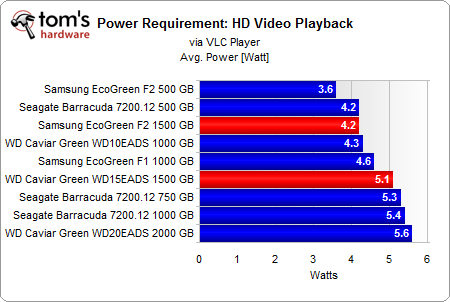1.5 TB Low-Power HDDs: Green Gets Big
Power Consumption And Efficiency
Power Consumption
Power requirements depend on the drive generation (newer drives require less power) and the total amount of rotating platters. This is why the four-platter 2 TB WD20EADS top model requires the most power. The two Barracudas at 3.9 and 5.0 W run on three platters and 7,200 RPM, while the first Samsung EcoGreen F1 drive wasn’t as efficient as the two drives we reviewed. WD’s idle power is even lower than the 3.8 W we measured on the Samsung F2 EcoGreen. Keep in mind that these idle power numbers are close to what first generation high-end 2.5” notebook hard drives required.
Delivering data at peak throughput has its price: the power requirements almost double. In this case, Samsung wins by requiring 0.7 W less power.
Playing HD video requires a constant stream of data, but the stream is far from the peak throughput of the drives. Samsung’s 4.2 W for HD video playback is an excellent result, which can only be beaten by two drives that are based on a single platter design. WD’s drive requires significantly more power in this benchmark category.
We also looked at power requirements during maximum I/O operations, and found that WD’s Caviar Green—again—requires a bit more than the Samsung drive. However, the difference is rather small in this test.
Power Efficiency: Performance per Watt
In this test, we looked at the streaming read performance and divided the results by the power required. A higher result means a better efficiency result, expressed in performance per watt (throughput per watt). The Spinpoint F2 EcoGreen delivers more throughput at lower power consumption, which is why it wins this category.
Get Tom's Hardware's best news and in-depth reviews, straight to your inbox.
Western Digital’s Caviar Green is much quicker at I/O requests and in access time. The performance advantage is large enough to have it win the efficiency test for workstation I/O, although WD’s drive requires slightly more power with this workload type than does the Samsung drive.
Current page: Power Consumption And Efficiency
Prev Page Benchmark Results: PCMark Vantage Application Benchmark Next Page Benchmark Results: Temperature And Sound Level




